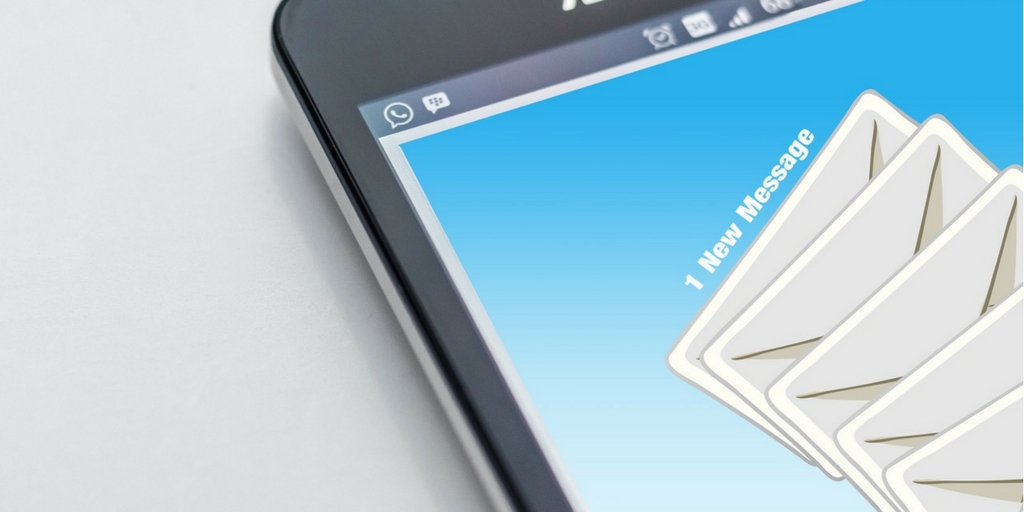
by Fronetics | Apr 10, 2017 | Blog, Content Marketing, Marketing, Strategy
Are your marketing emails annoying your customers and prospects?
We’ve all felt it: the visceral annoyance on opening an email — because it’s the fifth one from the same company in two days, or because it’s packed with hyperbole or an off-putting sales pitch. As it turns out, recent research has shown that this reaction is only too natural. We’re predisposed to view the tone of email more negatively than it was written.
Of course, email is an important tool for marketing your business. But it’s important to strike a balance, making sure you’re getting your message out without turning off potential buyers.
To help you achieve this delicate balance, here are three of the most off-putting email offenses — and tips to avoid them.
3 marketing email crimes to avoid
1) Imperatives
How many times a day do you receive emails, “Buy!” or, “Act fast!” in the subject line, usually followed with the anxiety-producing exclamation point? For most of us, this commanding language is irksome, and the emails end up in the trash folder.
Instead of commanding your potential buyers, try a subtle linguistic change. For example, rather than an imperative, try using the conditional: “Would you?” This way, you avoid coming across as overbearing, and you respect the right of your readers to make a decision about their actions.
2) Too many emails
It’s important to be conscientious and keep your message consistently on the minds of your target audience. But too many emails can be counterproductive, as your readers will start to tune you out or, worse, mark you as spam.
3) Failing to acknowledge your readers’ workload
Few things are more irksome in email correspondence than lack of consideration. Bear in mind that when your carefully crafted content pops up in your potential customer’s inbox, you’re giving them a task.
You can easily avoid potential annoyance on the part of your readers with a simple acknowledgment of their workload. For example, “I recognize that your schedule is hectic, so let me be brief…” This not only acknowledges that they are busy, but demonstrates that you respect, and will be a good steward of, their time.
The upshot is that while email is an excellent marketing tool, it’s important to always put yourself in the shoes of your readers before you press send. Make sure that your message isn’t getting overshadowed by avoiding these marketing email crimes.
Related posts:

by Fronetics | Nov 1, 2016 | Blog, Content Marketing, Marketing
Companies dedicate enormous resources to ramping up email marketing programs around seasonal pushes, like the holidays. But do they actually get more customers?
We all know the feeling — how the office buzzes, the anticipation starts to build. Busy season is around the corner, and your team is getting ready for the big push to make this the most successful year yet. But have you ever wondered if all the extra hours and money you pour into these seasonal marketing campaigns are worth it?
As the holidays approach, many businesses, especially retailers and e-commerce companies, are starting to ask themselves this question — or, at least, they should be. At what point will creating and sending another email to your database be detrimental, rather than beneficial? How much should your messaging change? Should you try something totally new and different to catch customers’ attention?
IBM Marketing Cloud’s 2016 Email Marketing Metrics Benchmark Study has some interesting answers to these questions.
The holiday email-marketing study
The 2016 Email Marketing Metrics Benchmark Study is an annual report that offers insight on how many people open, click, and ignore messages from email marketers around the globe. It aggregates data from messages sent by nearly 750 companies representing 3,000 brands in 40 countries. This year, the study also examined the performance of holiday messaging versus non-holiday messaging for retail/e-commerce vendors.
Most retailers send at least double the amount of emails during the holidays (defined as Thanksgiving to New Year’s) as they do during the non-holiday period. They entice potential buyers with aggressive pricing, free shipping, and deal deadlines. But do these more frequent, offer-loaded emails make a difference? Let’s take a look.
Click and open rates
In almost every respect, non-holiday emails outperformed holiday emails in a significant way. Open rates during the holidays were 18.8% lower than during non-holidays. Mean click-through rates differed by 28%. Mean click-to-open rates remained similar.
There are several takeaways here. Yes, open rates were lower during the holidays. But because the volume of emails sent during this period increased significantly, it’s likely that the total number of emails opened was greater during the holidays than non-holiday period. That’s a positive thing.
That being said, click-through rates decreased pretty dramatically. You would expect that special holiday offers would entice recipients to click through more often. But increased email volume seemed to detract from such motivating offers.
Similarly, click-to-open rates measure the effectiveness of email content (in driving a reader to take the requested action, e.g. redeem an offer). These rates remained relatively similar across both time periods, which is surprising. With more people looking to make purchases during the holidays, you would think that more recipients would act on the offers presented in the holiday emails. Again, increased email volume seemed to detract from their doing so.
List churn metrics
Increased email volume meant retailers processed more hard bounces, unsubscribes, and spam complaints during the holidays.
Here are the takeaways. Firstly, more emails equal more hard bounces. That seems logical enough.
Though unsubscribe and spam-complaint rates were slightly lower during the holidays, that doesn’t equal success. Because of the frequency math effect, retailers are losing a larger number of subscribers because they are sending more emails.
Say your company sends one email per week during the year, and two emails per week during the holidays. If you usually have 10 people unsubscribe per week during the year, approximately 20 people are unsubscribing during holiday weeks. That can deplete your database pretty quickly — especially if you’re more than doubling your email volume.
Conclusions
The folks at IBM Marketing Cloud had some interesting thoughts about their findings and how to increase the effectiveness of holiday emails.
For one, while increasing the number of emails you send during the holidays isn’t inherently a bad idea, as more emails equates to more total opens, many retailers are going about it the wrong way, as is evidenced by lagging click-through rates.
That’s because when many marketers ramp up email volume, they forget all the best practices that make their emails successful in the first place: personalization, targeted content, and offers that are relevant to the specific recipient based on his/her place in the buyer’s journey. Personalizing email content will help improve click-through and click-to-open rates, which could dramatically impact sales given the increased email volume.
Further, a courtesy head’s up about increasing email frequency could reduce the number of opt-outs and spam complaints. IBM Marketing Cloud suggests that companies should “consider sending an email to subscribers before you ramp up frequency, explaining the increased frequency, what kind of promotions they can expect, and shipping and return policies. Include prominent language about frequency options and link to your preference center. In addition, revise your preference-center language and options to encourage unsubscribers to opt down or snooze emails instead of simply opting out.”
Application across verticals
While the weeks between Thanksgiving and New Year’s are not every business’s busy season, the findings from this study are still applicable. If your prospects experience an uptick in marketing emails during a particular season from you and your competitors, you’re likely to experience similar results.
The key in ramping up emails prior to a big push is to retain quality — that is, customizing content and offers to the particular recipient. If you can’t scale, then you shouldn’t send.
Furthermore, this study speaks to the value of a strategic, year-round marketing program that builds brand awareness and customer loyalty, regardless of how close the busy season is. If prospects grow to know and trust your brand, they’ll turn to you when it’s time to buy, regardless of how many emails you send them in the weeks prior.
Related posts:

by Fronetics | Oct 26, 2016 | Big Data, Blog, Content Marketing, Data/Analytics, Marketing
Big-data insights can help you segment your email database to better target prospects based on where they are in the buyers’ journey.
Most companies these days are swimming in a sea of big data, the great swaths of information they’ve amassed from sales records, social media connections, website leads and contacts, and online analytics.
At first glance it’s a tangle of information that is hard to organize and even harder to learn anything from. That’s a stumbling block that forward-looking businesses need to overcome. Big data can help breathe new life into one of the most reliable yet shopworn tools of the trade: email campaigns.
Embrace Big Data
A study by the executive head-hunting firm Spencer Stuart surveyed 171 companies regarding big-data usage. Just a little over half of the companies used their big data to help guide email, SEO, and SMS marketing campaigns. That’s a fairly low rate, given the potential leg-up that big data can provide.
Consider what Walmart is doing. The company has big-data information on about 60% of all Americans, with which it micro-targets customers based on their individual interests and habits. It’s a powerful strategy that is spreading quickly to businesses of all sizes.
How can you use big data to freshen up your email campaigns?
Be a Collector, Not a Hoarder
Chances are, you are obtaining a lot of data, especially if you have an active content marketing plan in place. Not all of the data you get is equally important. Your focus should be on data that can lead to an actionable and quick response — for example, are you gathering information on your customers’ buying habits? Do you know who they are, where they are, what their interests are, what their email address is, and how your business connects with them?
Collect that relevant data and study it. Much of it will come from the buyer’s journey — the breadcrumbs that potential buyers leave for you in your big data. These pieces of information are keys to your personalized email responses.
Respond In Kind
Most experts agree that a quick and targeted email response is a good strategy for encouraging a new customer to make a purchase. The email needs to respond directly to the buyer’s interests — using information you’ve (hopefully) logged with your big data.
From this point on, it’s crucial to make sure that every email that is sent to that buyer is built around a backbone of big data. Nurture your customers with personalized emails that offer content and deals that line up with their specific interests.
Don’t Mess with the Masses
Mass emails — the generic sales pitch email — used to be the cost-effective and simple way of reaching and converting customers. Now, it’s more than likely they’ll get sent to the trash, or worse, the spam filter. The mass email is your one-way ticket to spam purgatory.
“Traditional methods of mass marketing doesn’t resonate anymore and they’re being ignored by the audience,” said Volker Hildebrand, Global Vice President of Strategy at SAP Hybris, in a recent interview with Forbes. “Data is the fuel for customer engagement, and being able to pull together all the relevant information about in real-time.”
You can do better than the mass email approach. If you’ve collected relevant data and you’ve studied your buyers’ journeys, you have the tools in place to build a smart email campaign. Tailor your campaign to personalize your approach to your customers, and more than likely they’ll open that email.
Related posts:

by Fronetics | Sep 21, 2016 | Blog, Content Marketing, Marketing, Strategy
To truly gauge the effect of variations in frequency of marketing emails, evaluate the cumulative metrics as well as per-message statistics.
How often does your company send marketing emails? Perhaps you’ve wondered if ramping up the number of messages you send to your database may generate more purchases. But you don’t want to cross the line of bothering people to the point where they unsubscribe or become annoyed with your business.
IBM Marketing Cloud recently released the 2016 Email Marketing Metrics Benchmark Study, which aggregates data from messages sent by nearly 750 companies representing 3,000 brands in 40 countries. It offers interesting insight on metrics like open rates, click-throughs, and mobile metrics.
Marketing emails and the frequency math effect
One key finding from this year’s study involves something called the “frequency math effect.” It first became evident for businesses in the retail and ecommerce sector during the holidays but applies across verticals.
During periods of heavy email volume, certain metrics that determine the effectiveness of marketing emails — i.e., opens and clicks per message — may drop off drastically. But this is not necessarily cause for panic. If you look over the entire sending period, you are likely to see the number of total opens and clicks go up.
Because your subscribers are receiving more emails from you, they tend to open fewer of those messages. But because you are touching your subscribers more often, engagement increases, likely dramatically. This could lead to more conversions and higher revenue.
But there’s more to consider here. List churn metrics — e.g., hard bounces, unsubscribe rates, spam complaints — are also subject to the frequency math effect.
When you are sending marketing emails more frequently, you’ll likely see a drop in your unsubscribe rates, reports of abuse, etc. But don’t celebrate too soon. Again, the cumulative number of these actions will increase.
To better gauge the impact of marketing email frequency, it’s important to look at both per-message statistics and total open, click-through, and list churn metrics for an entire period. By doing so, you’ll be able to more accurately determine whether a change in marketing email frequency has driven an overall net positive or negative impact.
Related posts:

by Fronetics | Aug 18, 2016 | Blog, Content Marketing, Marketing, Strategy

Transactional emails offer prime real estate for driving further customer engagement or action.
Your business probably invests a lot of time and effort creating marketing emails to send to your prospects and consumers. But have you thought much about the content of your confirmation and thank you emails?
New findings from IBM Marketing Cloud’s 2016 Email Marketing Metrics Benchmark Study suggest you should. The survey “examines messages sent by nearly 750 companies and 3,000 brands in 2015, using a wide variety of measurements to establish benchmarks on customer engagement (via multiple open, click, and device/email client metrics) and list churn (hard bounces, unsubscribes, and complaints).”
One important finding relates to how recipients engage with transactional emails, messages confirming a purchase or an action (such as signing up for a newsletter). In almost every respect, transactional emails outperform non-transactional emails. For example:
- Transactional emails generate roughly 2x the open rates of non-transactional emails.
- Transactional emails generate roughly 3x the click-through rates of non-transactional emails.
This should not be a surprise, since these emails are based directly on a person’s purchase or action. But what many companies don’t realize is that these messages represent an opportunity to drive further customer engagement or action. Adding a prominent call to action can encourage the recipient to join your email list, make an additional purchase, or otherwise move further down the purchase path.
Instead of a simple “Thanks for your purchase!” email, put a little thought into how you might keep that person interacting with your business. Here are a few ideas:
1) Ask them to review their purchases.
Include a link to the recipient’s account or orders page. This gets them back on your website, where you can add additional calls to action, advertise related products, or encourage them to join a loyalty program.
2) Offer an incentive for future purchases.
Encourage recipients to buy again soon by providing a discount code for their next transaction. This also helps build brand loyalty by showing customers you value their business and want them to come back.
3) Request they follow you on social media.
Provide links to your various social media accounts to build additional touch points with your customers and prospects. Suggest they post photos of themselves using the products they purchased, share their purchase (or link to the newsletter sign-up, etc.) with their followers, or enter your contest or giveaway happening on these platforms.
4) Show them how to use their purchase.
Link to content that can improve their experience with the product or service they just bought. Step-by-steps guides, how-to videos, images of other buyers using the product: give them valuable support to improve their user experience and to keep them engaged with your content.
5) Display similar or related products.
What else do customers buy when they make the same purchase? Do you have other products or services that go along with it? For example, someone buying a hammer might also be interested in nails, toolboxes, or screwdrivers.
6) Ask them to join your loyalty or rewards program.
This is another way to offer incentives for future purchases and exclusive access to deals while your business gains additional information about the person.
7) Request they sign up for your newsletter, join your email list, or subscribe to your blog.
Encourage them to stay in the loop by opting into your content. You’ll stay in the sights of potential buyers that aren’t ready to make a purchase, and be on their mind when the time comes to buy.
Related posts:





